Rainwater Harvesting in Sydney: Facts, Figures, and Analysis
VerifiedAdded on 2020/04/01
|15
|5789
|80
Report
AI Summary
This report delves into the practice of rainwater harvesting, specifically focusing on its application and impact in Sydney, Australia. It begins with an introduction outlining the background of water scarcity in Australia, the research aims and objectives, and the scope of the study. The report provides key water-related facts and figures for both Australia and Sydney, highlighting government actions and initiatives like BASIX and rainwater tank rebates. A comprehensive literature review explores worldwide and Australian research on rainwater harvesting, including its future scenarios and benefits. The study examines various aspects of rainwater harvesting, including the size and types of rainwater tanks, and their role in water conservation. The report analyzes the government's role in promoting water conservation and the effectiveness of different programs. The study provides an in-depth analysis of the challenges and opportunities associated with rainwater harvesting, offering insights into sustainable water management practices.
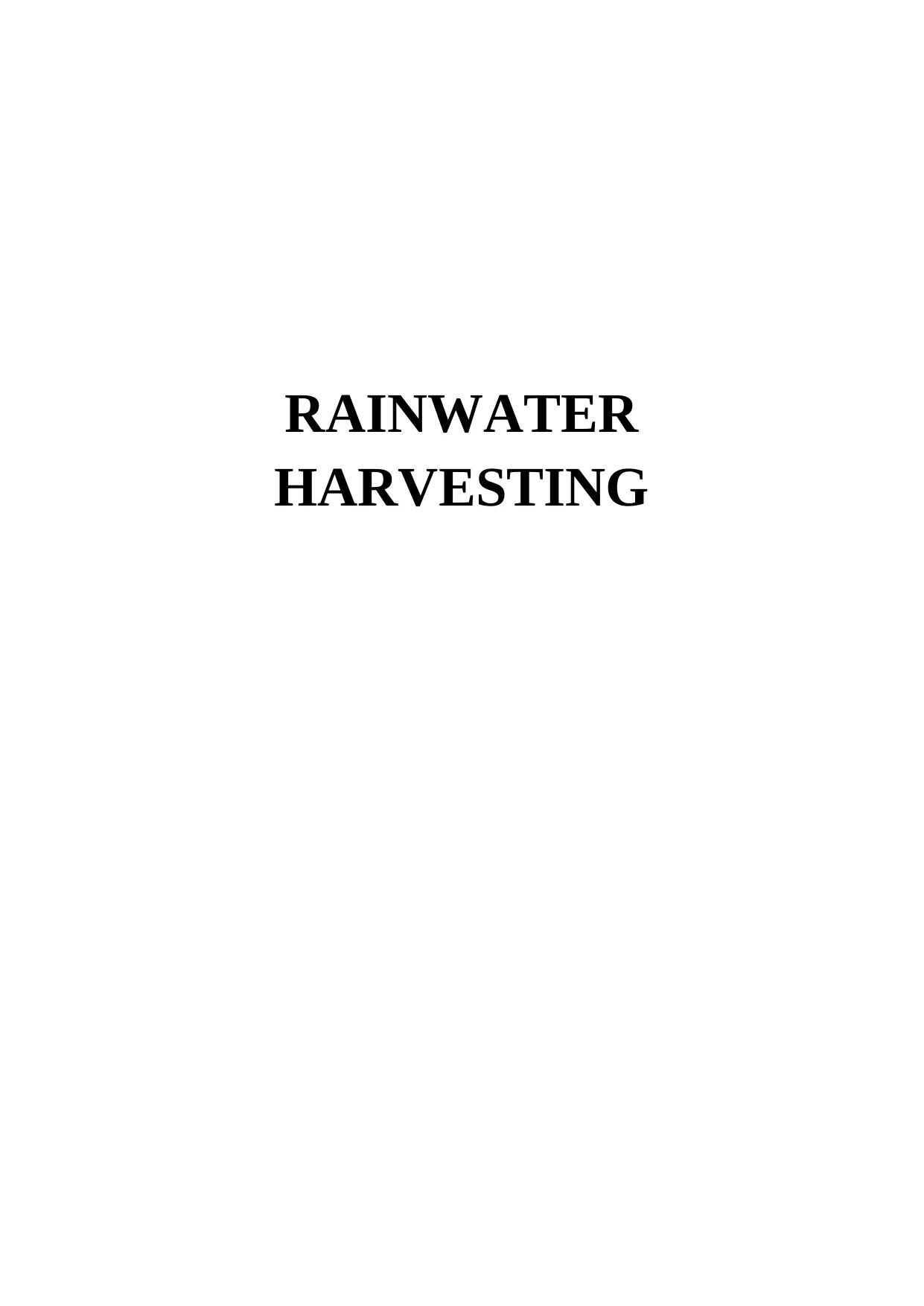
RAINWATER
HARVESTING
HARVESTING
Paraphrase This Document
Need a fresh take? Get an instant paraphrase of this document with our AI Paraphraser
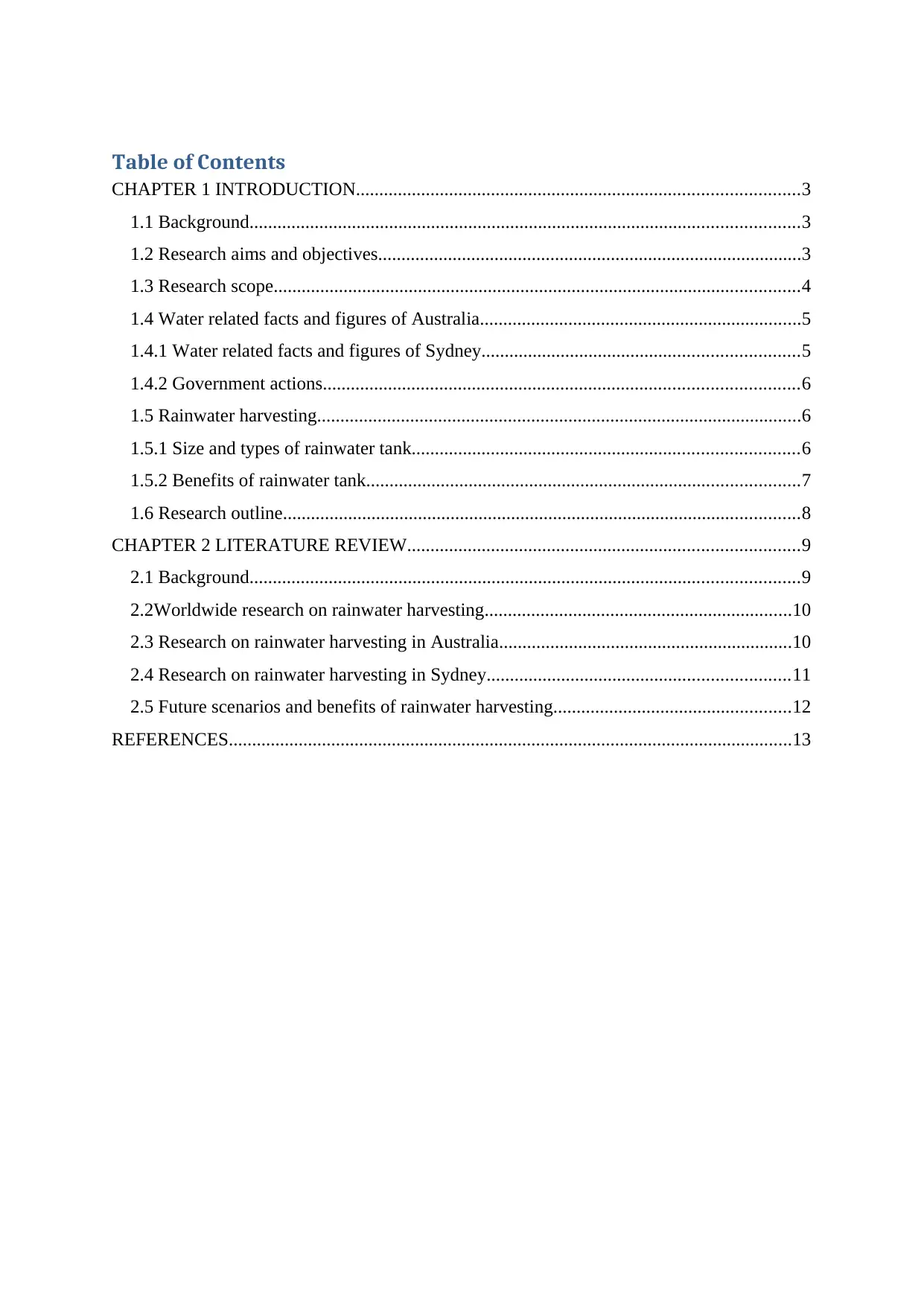
Table of Contents
CHAPTER 1 INTRODUCTION...............................................................................................3
1.1 Background......................................................................................................................3
1.2 Research aims and objectives...........................................................................................3
1.3 Research scope.................................................................................................................4
1.4 Water related facts and figures of Australia.....................................................................5
1.4.1 Water related facts and figures of Sydney....................................................................5
1.4.2 Government actions......................................................................................................6
1.5 Rainwater harvesting........................................................................................................6
1.5.1 Size and types of rainwater tank...................................................................................6
1.5.2 Benefits of rainwater tank.............................................................................................7
1.6 Research outline...............................................................................................................8
CHAPTER 2 LITERATURE REVIEW....................................................................................9
2.1 Background......................................................................................................................9
2.2Worldwide research on rainwater harvesting..................................................................10
2.3 Research on rainwater harvesting in Australia...............................................................10
2.4 Research on rainwater harvesting in Sydney.................................................................11
2.5 Future scenarios and benefits of rainwater harvesting...................................................12
REFERENCES.........................................................................................................................13
CHAPTER 1 INTRODUCTION...............................................................................................3
1.1 Background......................................................................................................................3
1.2 Research aims and objectives...........................................................................................3
1.3 Research scope.................................................................................................................4
1.4 Water related facts and figures of Australia.....................................................................5
1.4.1 Water related facts and figures of Sydney....................................................................5
1.4.2 Government actions......................................................................................................6
1.5 Rainwater harvesting........................................................................................................6
1.5.1 Size and types of rainwater tank...................................................................................6
1.5.2 Benefits of rainwater tank.............................................................................................7
1.6 Research outline...............................................................................................................8
CHAPTER 2 LITERATURE REVIEW....................................................................................9
2.1 Background......................................................................................................................9
2.2Worldwide research on rainwater harvesting..................................................................10
2.3 Research on rainwater harvesting in Australia...............................................................10
2.4 Research on rainwater harvesting in Sydney.................................................................11
2.5 Future scenarios and benefits of rainwater harvesting...................................................12
REFERENCES.........................................................................................................................13
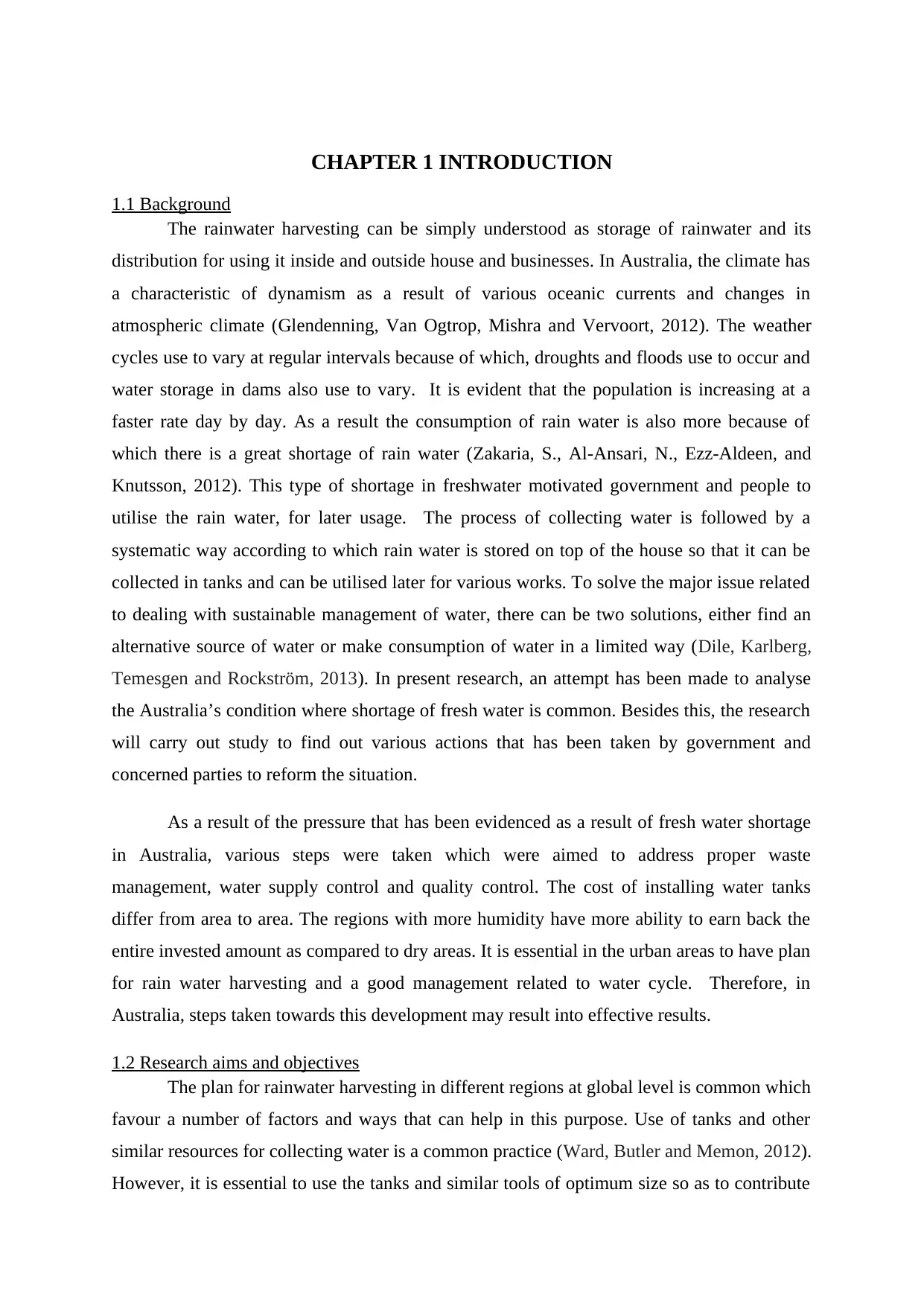
CHAPTER 1 INTRODUCTION
1.1 Background
The rainwater harvesting can be simply understood as storage of rainwater and its
distribution for using it inside and outside house and businesses. In Australia, the climate has
a characteristic of dynamism as a result of various oceanic currents and changes in
atmospheric climate (Glendenning, Van Ogtrop, Mishra and Vervoort, 2012). The weather
cycles use to vary at regular intervals because of which, droughts and floods use to occur and
water storage in dams also use to vary. It is evident that the population is increasing at a
faster rate day by day. As a result the consumption of rain water is also more because of
which there is a great shortage of rain water (Zakaria, S., Al-Ansari, N., Ezz-Aldeen, and
Knutsson, 2012). This type of shortage in freshwater motivated government and people to
utilise the rain water, for later usage. The process of collecting water is followed by a
systematic way according to which rain water is stored on top of the house so that it can be
collected in tanks and can be utilised later for various works. To solve the major issue related
to dealing with sustainable management of water, there can be two solutions, either find an
alternative source of water or make consumption of water in a limited way (Dile, Karlberg,
Temesgen and Rockström, 2013). In present research, an attempt has been made to analyse
the Australia’s condition where shortage of fresh water is common. Besides this, the research
will carry out study to find out various actions that has been taken by government and
concerned parties to reform the situation.
As a result of the pressure that has been evidenced as a result of fresh water shortage
in Australia, various steps were taken which were aimed to address proper waste
management, water supply control and quality control. The cost of installing water tanks
differ from area to area. The regions with more humidity have more ability to earn back the
entire invested amount as compared to dry areas. It is essential in the urban areas to have plan
for rain water harvesting and a good management related to water cycle. Therefore, in
Australia, steps taken towards this development may result into effective results.
1.2 Research aims and objectives
The plan for rainwater harvesting in different regions at global level is common which
favour a number of factors and ways that can help in this purpose. Use of tanks and other
similar resources for collecting water is a common practice (Ward, Butler and Memon, 2012).
However, it is essential to use the tanks and similar tools of optimum size so as to contribute
1.1 Background
The rainwater harvesting can be simply understood as storage of rainwater and its
distribution for using it inside and outside house and businesses. In Australia, the climate has
a characteristic of dynamism as a result of various oceanic currents and changes in
atmospheric climate (Glendenning, Van Ogtrop, Mishra and Vervoort, 2012). The weather
cycles use to vary at regular intervals because of which, droughts and floods use to occur and
water storage in dams also use to vary. It is evident that the population is increasing at a
faster rate day by day. As a result the consumption of rain water is also more because of
which there is a great shortage of rain water (Zakaria, S., Al-Ansari, N., Ezz-Aldeen, and
Knutsson, 2012). This type of shortage in freshwater motivated government and people to
utilise the rain water, for later usage. The process of collecting water is followed by a
systematic way according to which rain water is stored on top of the house so that it can be
collected in tanks and can be utilised later for various works. To solve the major issue related
to dealing with sustainable management of water, there can be two solutions, either find an
alternative source of water or make consumption of water in a limited way (Dile, Karlberg,
Temesgen and Rockström, 2013). In present research, an attempt has been made to analyse
the Australia’s condition where shortage of fresh water is common. Besides this, the research
will carry out study to find out various actions that has been taken by government and
concerned parties to reform the situation.
As a result of the pressure that has been evidenced as a result of fresh water shortage
in Australia, various steps were taken which were aimed to address proper waste
management, water supply control and quality control. The cost of installing water tanks
differ from area to area. The regions with more humidity have more ability to earn back the
entire invested amount as compared to dry areas. It is essential in the urban areas to have plan
for rain water harvesting and a good management related to water cycle. Therefore, in
Australia, steps taken towards this development may result into effective results.
1.2 Research aims and objectives
The plan for rainwater harvesting in different regions at global level is common which
favour a number of factors and ways that can help in this purpose. Use of tanks and other
similar resources for collecting water is a common practice (Ward, Butler and Memon, 2012).
However, it is essential to use the tanks and similar tools of optimum size so as to contribute
⊘ This is a preview!⊘
Do you want full access?
Subscribe today to unlock all pages.

Trusted by 1+ million students worldwide
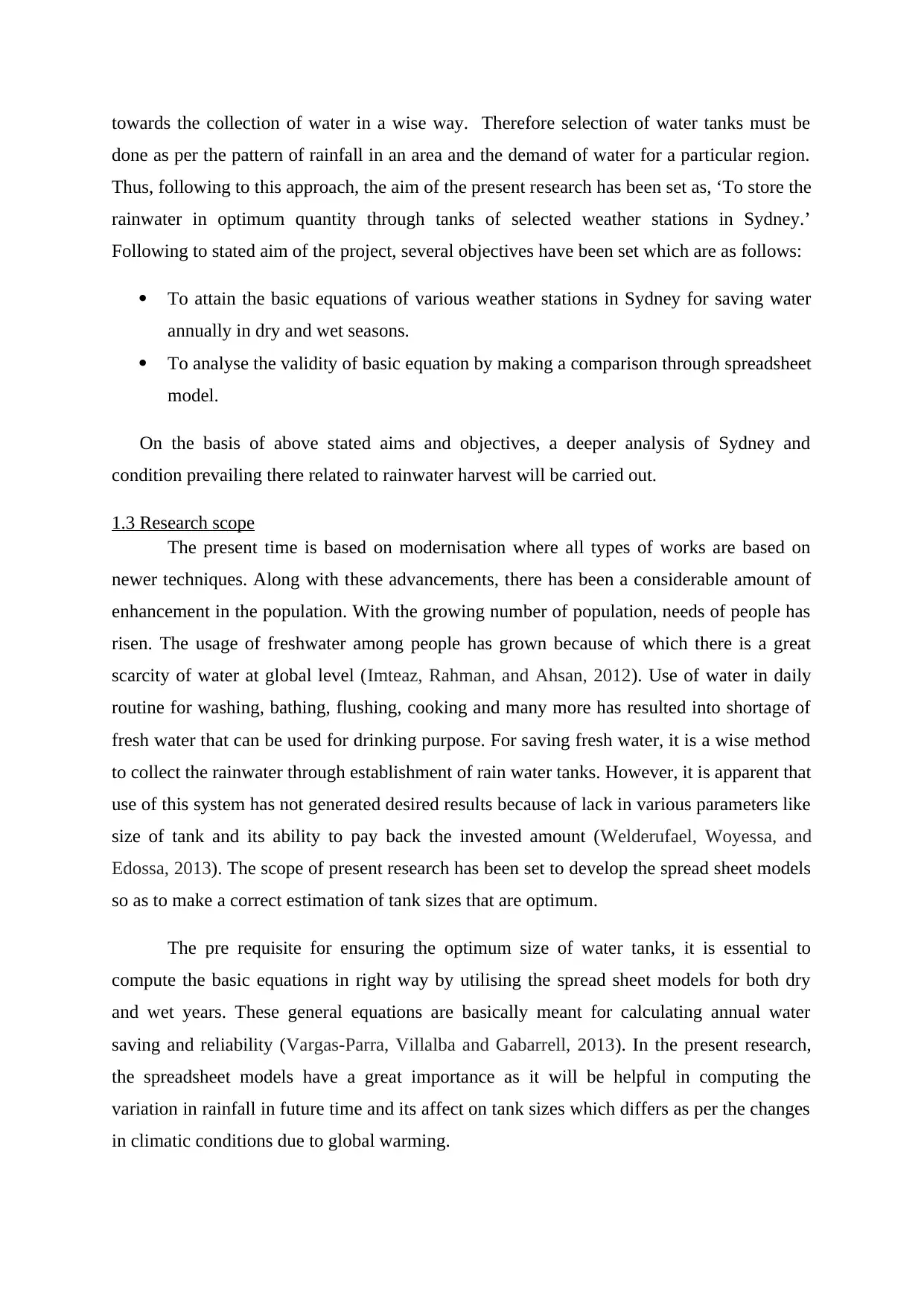
towards the collection of water in a wise way. Therefore selection of water tanks must be
done as per the pattern of rainfall in an area and the demand of water for a particular region.
Thus, following to this approach, the aim of the present research has been set as, ‘To store the
rainwater in optimum quantity through tanks of selected weather stations in Sydney.’
Following to stated aim of the project, several objectives have been set which are as follows:
To attain the basic equations of various weather stations in Sydney for saving water
annually in dry and wet seasons.
To analyse the validity of basic equation by making a comparison through spreadsheet
model.
On the basis of above stated aims and objectives, a deeper analysis of Sydney and
condition prevailing there related to rainwater harvest will be carried out.
1.3 Research scope
The present time is based on modernisation where all types of works are based on
newer techniques. Along with these advancements, there has been a considerable amount of
enhancement in the population. With the growing number of population, needs of people has
risen. The usage of freshwater among people has grown because of which there is a great
scarcity of water at global level (Imteaz, Rahman, and Ahsan, 2012). Use of water in daily
routine for washing, bathing, flushing, cooking and many more has resulted into shortage of
fresh water that can be used for drinking purpose. For saving fresh water, it is a wise method
to collect the rainwater through establishment of rain water tanks. However, it is apparent that
use of this system has not generated desired results because of lack in various parameters like
size of tank and its ability to pay back the invested amount (Welderufael, Woyessa, and
Edossa, 2013). The scope of present research has been set to develop the spread sheet models
so as to make a correct estimation of tank sizes that are optimum.
The pre requisite for ensuring the optimum size of water tanks, it is essential to
compute the basic equations in right way by utilising the spread sheet models for both dry
and wet years. These general equations are basically meant for calculating annual water
saving and reliability (Vargas-Parra, Villalba and Gabarrell, 2013). In the present research,
the spreadsheet models have a great importance as it will be helpful in computing the
variation in rainfall in future time and its affect on tank sizes which differs as per the changes
in climatic conditions due to global warming.
done as per the pattern of rainfall in an area and the demand of water for a particular region.
Thus, following to this approach, the aim of the present research has been set as, ‘To store the
rainwater in optimum quantity through tanks of selected weather stations in Sydney.’
Following to stated aim of the project, several objectives have been set which are as follows:
To attain the basic equations of various weather stations in Sydney for saving water
annually in dry and wet seasons.
To analyse the validity of basic equation by making a comparison through spreadsheet
model.
On the basis of above stated aims and objectives, a deeper analysis of Sydney and
condition prevailing there related to rainwater harvest will be carried out.
1.3 Research scope
The present time is based on modernisation where all types of works are based on
newer techniques. Along with these advancements, there has been a considerable amount of
enhancement in the population. With the growing number of population, needs of people has
risen. The usage of freshwater among people has grown because of which there is a great
scarcity of water at global level (Imteaz, Rahman, and Ahsan, 2012). Use of water in daily
routine for washing, bathing, flushing, cooking and many more has resulted into shortage of
fresh water that can be used for drinking purpose. For saving fresh water, it is a wise method
to collect the rainwater through establishment of rain water tanks. However, it is apparent that
use of this system has not generated desired results because of lack in various parameters like
size of tank and its ability to pay back the invested amount (Welderufael, Woyessa, and
Edossa, 2013). The scope of present research has been set to develop the spread sheet models
so as to make a correct estimation of tank sizes that are optimum.
The pre requisite for ensuring the optimum size of water tanks, it is essential to
compute the basic equations in right way by utilising the spread sheet models for both dry
and wet years. These general equations are basically meant for calculating annual water
saving and reliability (Vargas-Parra, Villalba and Gabarrell, 2013). In the present research,
the spreadsheet models have a great importance as it will be helpful in computing the
variation in rainfall in future time and its affect on tank sizes which differs as per the changes
in climatic conditions due to global warming.
Paraphrase This Document
Need a fresh take? Get an instant paraphrase of this document with our AI Paraphraser
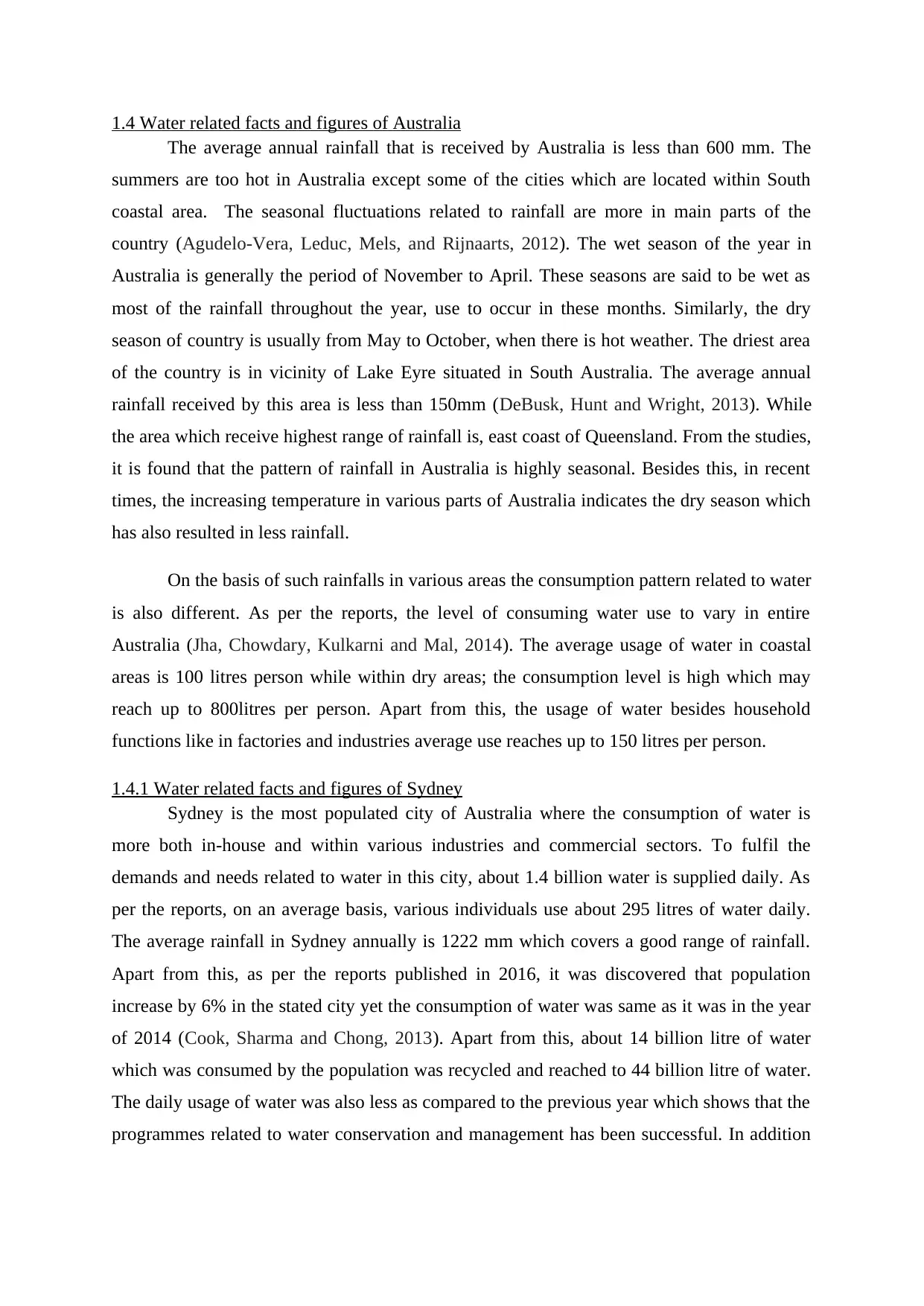
1.4 Water related facts and figures of Australia
The average annual rainfall that is received by Australia is less than 600 mm. The
summers are too hot in Australia except some of the cities which are located within South
coastal area. The seasonal fluctuations related to rainfall are more in main parts of the
country (Agudelo-Vera, Leduc, Mels, and Rijnaarts, 2012). The wet season of the year in
Australia is generally the period of November to April. These seasons are said to be wet as
most of the rainfall throughout the year, use to occur in these months. Similarly, the dry
season of country is usually from May to October, when there is hot weather. The driest area
of the country is in vicinity of Lake Eyre situated in South Australia. The average annual
rainfall received by this area is less than 150mm (DeBusk, Hunt and Wright, 2013). While
the area which receive highest range of rainfall is, east coast of Queensland. From the studies,
it is found that the pattern of rainfall in Australia is highly seasonal. Besides this, in recent
times, the increasing temperature in various parts of Australia indicates the dry season which
has also resulted in less rainfall.
On the basis of such rainfalls in various areas the consumption pattern related to water
is also different. As per the reports, the level of consuming water use to vary in entire
Australia (Jha, Chowdary, Kulkarni and Mal, 2014). The average usage of water in coastal
areas is 100 litres person while within dry areas; the consumption level is high which may
reach up to 800litres per person. Apart from this, the usage of water besides household
functions like in factories and industries average use reaches up to 150 litres per person.
1.4.1 Water related facts and figures of Sydney
Sydney is the most populated city of Australia where the consumption of water is
more both in-house and within various industries and commercial sectors. To fulfil the
demands and needs related to water in this city, about 1.4 billion water is supplied daily. As
per the reports, on an average basis, various individuals use about 295 litres of water daily.
The average rainfall in Sydney annually is 1222 mm which covers a good range of rainfall.
Apart from this, as per the reports published in 2016, it was discovered that population
increase by 6% in the stated city yet the consumption of water was same as it was in the year
of 2014 (Cook, Sharma and Chong, 2013). Apart from this, about 14 billion litre of water
which was consumed by the population was recycled and reached to 44 billion litre of water.
The daily usage of water was also less as compared to the previous year which shows that the
programmes related to water conservation and management has been successful. In addition
The average annual rainfall that is received by Australia is less than 600 mm. The
summers are too hot in Australia except some of the cities which are located within South
coastal area. The seasonal fluctuations related to rainfall are more in main parts of the
country (Agudelo-Vera, Leduc, Mels, and Rijnaarts, 2012). The wet season of the year in
Australia is generally the period of November to April. These seasons are said to be wet as
most of the rainfall throughout the year, use to occur in these months. Similarly, the dry
season of country is usually from May to October, when there is hot weather. The driest area
of the country is in vicinity of Lake Eyre situated in South Australia. The average annual
rainfall received by this area is less than 150mm (DeBusk, Hunt and Wright, 2013). While
the area which receive highest range of rainfall is, east coast of Queensland. From the studies,
it is found that the pattern of rainfall in Australia is highly seasonal. Besides this, in recent
times, the increasing temperature in various parts of Australia indicates the dry season which
has also resulted in less rainfall.
On the basis of such rainfalls in various areas the consumption pattern related to water
is also different. As per the reports, the level of consuming water use to vary in entire
Australia (Jha, Chowdary, Kulkarni and Mal, 2014). The average usage of water in coastal
areas is 100 litres person while within dry areas; the consumption level is high which may
reach up to 800litres per person. Apart from this, the usage of water besides household
functions like in factories and industries average use reaches up to 150 litres per person.
1.4.1 Water related facts and figures of Sydney
Sydney is the most populated city of Australia where the consumption of water is
more both in-house and within various industries and commercial sectors. To fulfil the
demands and needs related to water in this city, about 1.4 billion water is supplied daily. As
per the reports, on an average basis, various individuals use about 295 litres of water daily.
The average rainfall in Sydney annually is 1222 mm which covers a good range of rainfall.
Apart from this, as per the reports published in 2016, it was discovered that population
increase by 6% in the stated city yet the consumption of water was same as it was in the year
of 2014 (Cook, Sharma and Chong, 2013). Apart from this, about 14 billion litre of water
which was consumed by the population was recycled and reached to 44 billion litre of water.
The daily usage of water was also less as compared to the previous year which shows that the
programmes related to water conservation and management has been successful. In addition
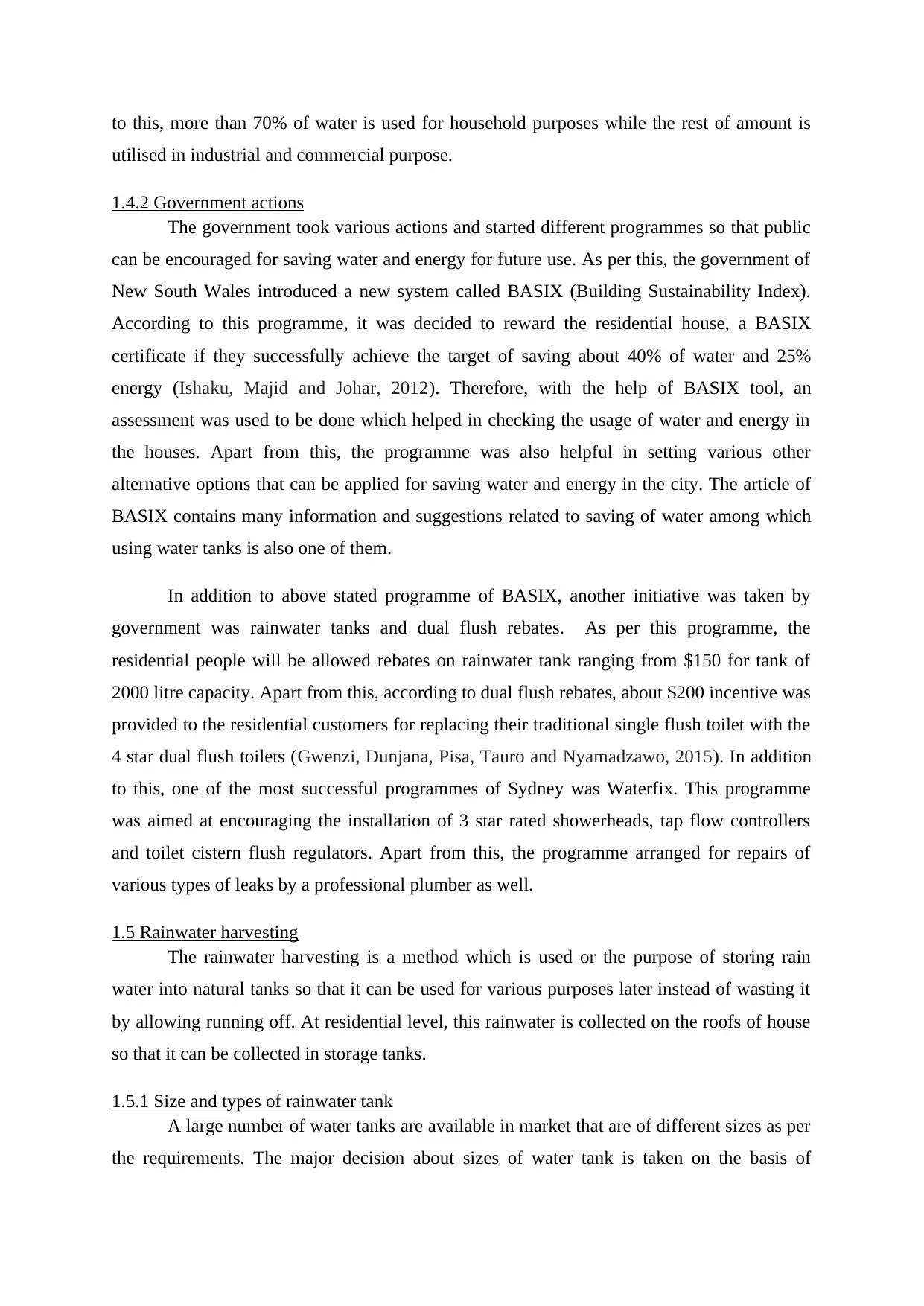
to this, more than 70% of water is used for household purposes while the rest of amount is
utilised in industrial and commercial purpose.
1.4.2 Government actions
The government took various actions and started different programmes so that public
can be encouraged for saving water and energy for future use. As per this, the government of
New South Wales introduced a new system called BASIX (Building Sustainability Index).
According to this programme, it was decided to reward the residential house, a BASIX
certificate if they successfully achieve the target of saving about 40% of water and 25%
energy (Ishaku, Majid and Johar, 2012). Therefore, with the help of BASIX tool, an
assessment was used to be done which helped in checking the usage of water and energy in
the houses. Apart from this, the programme was also helpful in setting various other
alternative options that can be applied for saving water and energy in the city. The article of
BASIX contains many information and suggestions related to saving of water among which
using water tanks is also one of them.
In addition to above stated programme of BASIX, another initiative was taken by
government was rainwater tanks and dual flush rebates. As per this programme, the
residential people will be allowed rebates on rainwater tank ranging from $150 for tank of
2000 litre capacity. Apart from this, according to dual flush rebates, about $200 incentive was
provided to the residential customers for replacing their traditional single flush toilet with the
4 star dual flush toilets (Gwenzi, Dunjana, Pisa, Tauro and Nyamadzawo, 2015). In addition
to this, one of the most successful programmes of Sydney was Waterfix. This programme
was aimed at encouraging the installation of 3 star rated showerheads, tap flow controllers
and toilet cistern flush regulators. Apart from this, the programme arranged for repairs of
various types of leaks by a professional plumber as well.
1.5 Rainwater harvesting
The rainwater harvesting is a method which is used or the purpose of storing rain
water into natural tanks so that it can be used for various purposes later instead of wasting it
by allowing running off. At residential level, this rainwater is collected on the roofs of house
so that it can be collected in storage tanks.
1.5.1 Size and types of rainwater tank
A large number of water tanks are available in market that are of different sizes as per
the requirements. The major decision about sizes of water tank is taken on the basis of
utilised in industrial and commercial purpose.
1.4.2 Government actions
The government took various actions and started different programmes so that public
can be encouraged for saving water and energy for future use. As per this, the government of
New South Wales introduced a new system called BASIX (Building Sustainability Index).
According to this programme, it was decided to reward the residential house, a BASIX
certificate if they successfully achieve the target of saving about 40% of water and 25%
energy (Ishaku, Majid and Johar, 2012). Therefore, with the help of BASIX tool, an
assessment was used to be done which helped in checking the usage of water and energy in
the houses. Apart from this, the programme was also helpful in setting various other
alternative options that can be applied for saving water and energy in the city. The article of
BASIX contains many information and suggestions related to saving of water among which
using water tanks is also one of them.
In addition to above stated programme of BASIX, another initiative was taken by
government was rainwater tanks and dual flush rebates. As per this programme, the
residential people will be allowed rebates on rainwater tank ranging from $150 for tank of
2000 litre capacity. Apart from this, according to dual flush rebates, about $200 incentive was
provided to the residential customers for replacing their traditional single flush toilet with the
4 star dual flush toilets (Gwenzi, Dunjana, Pisa, Tauro and Nyamadzawo, 2015). In addition
to this, one of the most successful programmes of Sydney was Waterfix. This programme
was aimed at encouraging the installation of 3 star rated showerheads, tap flow controllers
and toilet cistern flush regulators. Apart from this, the programme arranged for repairs of
various types of leaks by a professional plumber as well.
1.5 Rainwater harvesting
The rainwater harvesting is a method which is used or the purpose of storing rain
water into natural tanks so that it can be used for various purposes later instead of wasting it
by allowing running off. At residential level, this rainwater is collected on the roofs of house
so that it can be collected in storage tanks.
1.5.1 Size and types of rainwater tank
A large number of water tanks are available in market that are of different sizes as per
the requirements. The major decision about sizes of water tank is taken on the basis of
⊘ This is a preview!⊘
Do you want full access?
Subscribe today to unlock all pages.

Trusted by 1+ million students worldwide
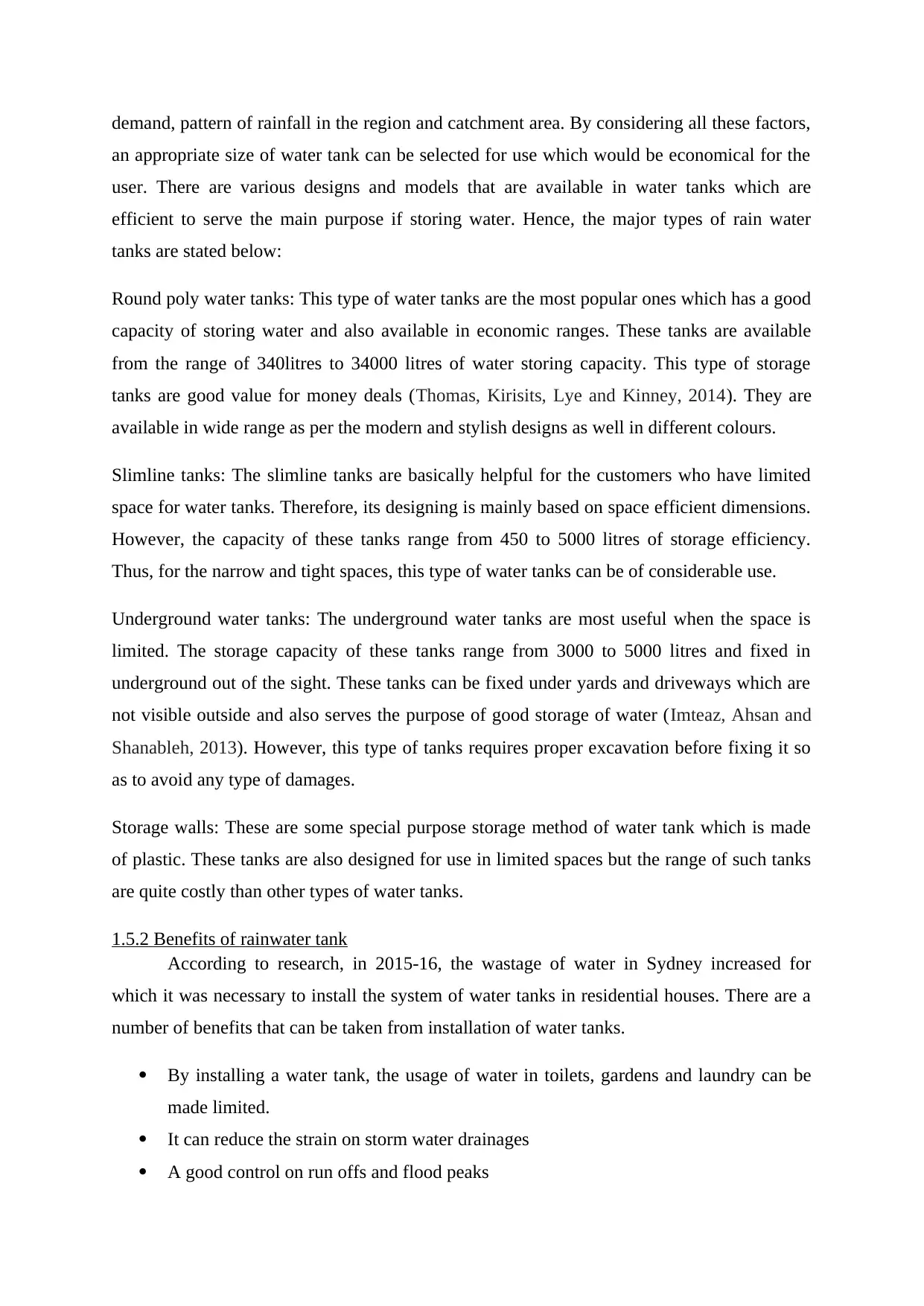
demand, pattern of rainfall in the region and catchment area. By considering all these factors,
an appropriate size of water tank can be selected for use which would be economical for the
user. There are various designs and models that are available in water tanks which are
efficient to serve the main purpose if storing water. Hence, the major types of rain water
tanks are stated below:
Round poly water tanks: This type of water tanks are the most popular ones which has a good
capacity of storing water and also available in economic ranges. These tanks are available
from the range of 340litres to 34000 litres of water storing capacity. This type of storage
tanks are good value for money deals (Thomas, Kirisits, Lye and Kinney, 2014). They are
available in wide range as per the modern and stylish designs as well in different colours.
Slimline tanks: The slimline tanks are basically helpful for the customers who have limited
space for water tanks. Therefore, its designing is mainly based on space efficient dimensions.
However, the capacity of these tanks range from 450 to 5000 litres of storage efficiency.
Thus, for the narrow and tight spaces, this type of water tanks can be of considerable use.
Underground water tanks: The underground water tanks are most useful when the space is
limited. The storage capacity of these tanks range from 3000 to 5000 litres and fixed in
underground out of the sight. These tanks can be fixed under yards and driveways which are
not visible outside and also serves the purpose of good storage of water (Imteaz, Ahsan and
Shanableh, 2013). However, this type of tanks requires proper excavation before fixing it so
as to avoid any type of damages.
Storage walls: These are some special purpose storage method of water tank which is made
of plastic. These tanks are also designed for use in limited spaces but the range of such tanks
are quite costly than other types of water tanks.
1.5.2 Benefits of rainwater tank
According to research, in 2015-16, the wastage of water in Sydney increased for
which it was necessary to install the system of water tanks in residential houses. There are a
number of benefits that can be taken from installation of water tanks.
By installing a water tank, the usage of water in toilets, gardens and laundry can be
made limited.
It can reduce the strain on storm water drainages
A good control on run offs and flood peaks
an appropriate size of water tank can be selected for use which would be economical for the
user. There are various designs and models that are available in water tanks which are
efficient to serve the main purpose if storing water. Hence, the major types of rain water
tanks are stated below:
Round poly water tanks: This type of water tanks are the most popular ones which has a good
capacity of storing water and also available in economic ranges. These tanks are available
from the range of 340litres to 34000 litres of water storing capacity. This type of storage
tanks are good value for money deals (Thomas, Kirisits, Lye and Kinney, 2014). They are
available in wide range as per the modern and stylish designs as well in different colours.
Slimline tanks: The slimline tanks are basically helpful for the customers who have limited
space for water tanks. Therefore, its designing is mainly based on space efficient dimensions.
However, the capacity of these tanks range from 450 to 5000 litres of storage efficiency.
Thus, for the narrow and tight spaces, this type of water tanks can be of considerable use.
Underground water tanks: The underground water tanks are most useful when the space is
limited. The storage capacity of these tanks range from 3000 to 5000 litres and fixed in
underground out of the sight. These tanks can be fixed under yards and driveways which are
not visible outside and also serves the purpose of good storage of water (Imteaz, Ahsan and
Shanableh, 2013). However, this type of tanks requires proper excavation before fixing it so
as to avoid any type of damages.
Storage walls: These are some special purpose storage method of water tank which is made
of plastic. These tanks are also designed for use in limited spaces but the range of such tanks
are quite costly than other types of water tanks.
1.5.2 Benefits of rainwater tank
According to research, in 2015-16, the wastage of water in Sydney increased for
which it was necessary to install the system of water tanks in residential houses. There are a
number of benefits that can be taken from installation of water tanks.
By installing a water tank, the usage of water in toilets, gardens and laundry can be
made limited.
It can reduce the strain on storm water drainages
A good control on run offs and flood peaks
Paraphrase This Document
Need a fresh take? Get an instant paraphrase of this document with our AI Paraphraser
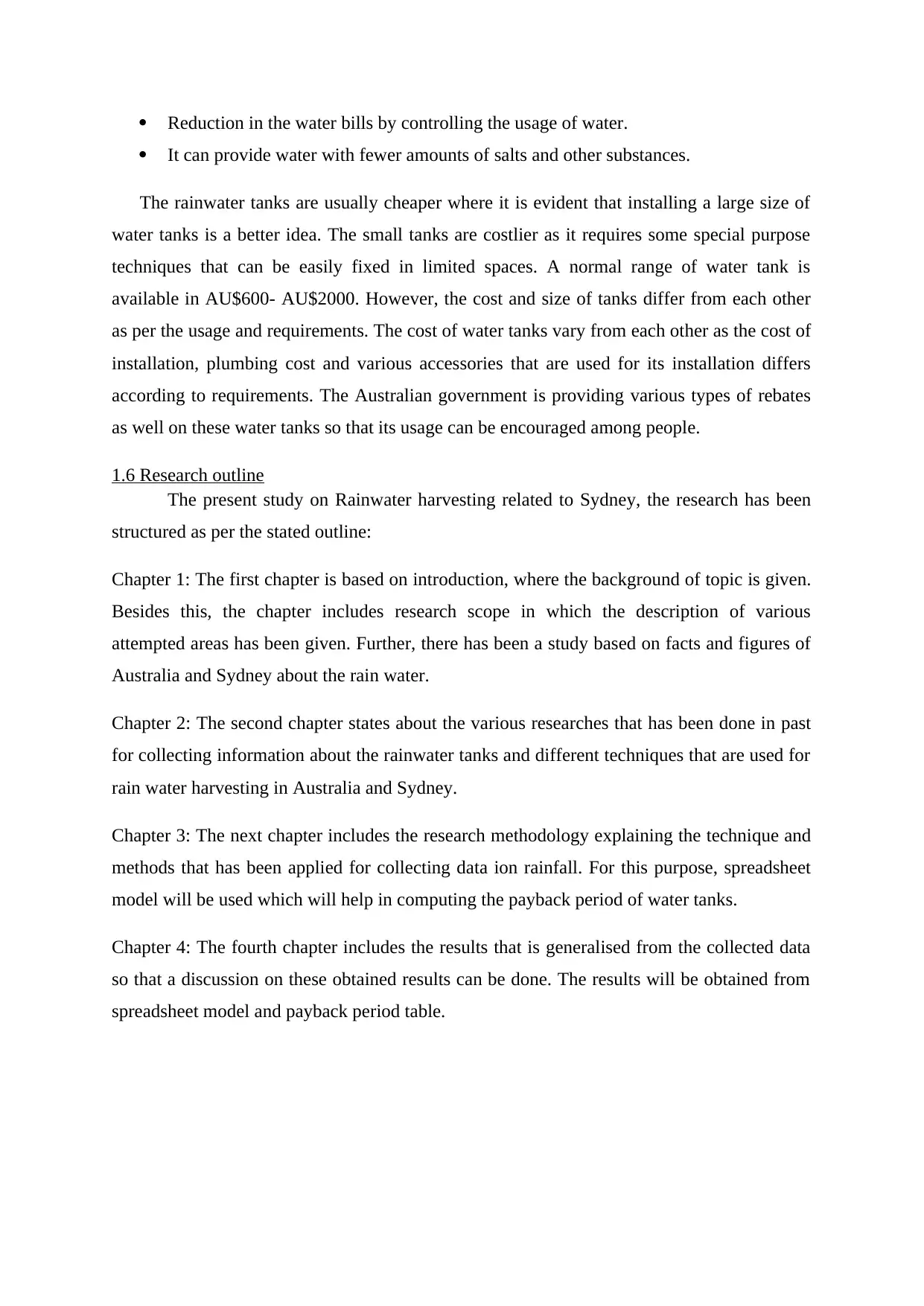
Reduction in the water bills by controlling the usage of water.
It can provide water with fewer amounts of salts and other substances.
The rainwater tanks are usually cheaper where it is evident that installing a large size of
water tanks is a better idea. The small tanks are costlier as it requires some special purpose
techniques that can be easily fixed in limited spaces. A normal range of water tank is
available in AU$600- AU$2000. However, the cost and size of tanks differ from each other
as per the usage and requirements. The cost of water tanks vary from each other as the cost of
installation, plumbing cost and various accessories that are used for its installation differs
according to requirements. The Australian government is providing various types of rebates
as well on these water tanks so that its usage can be encouraged among people.
1.6 Research outline
The present study on Rainwater harvesting related to Sydney, the research has been
structured as per the stated outline:
Chapter 1: The first chapter is based on introduction, where the background of topic is given.
Besides this, the chapter includes research scope in which the description of various
attempted areas has been given. Further, there has been a study based on facts and figures of
Australia and Sydney about the rain water.
Chapter 2: The second chapter states about the various researches that has been done in past
for collecting information about the rainwater tanks and different techniques that are used for
rain water harvesting in Australia and Sydney.
Chapter 3: The next chapter includes the research methodology explaining the technique and
methods that has been applied for collecting data ion rainfall. For this purpose, spreadsheet
model will be used which will help in computing the payback period of water tanks.
Chapter 4: The fourth chapter includes the results that is generalised from the collected data
so that a discussion on these obtained results can be done. The results will be obtained from
spreadsheet model and payback period table.
It can provide water with fewer amounts of salts and other substances.
The rainwater tanks are usually cheaper where it is evident that installing a large size of
water tanks is a better idea. The small tanks are costlier as it requires some special purpose
techniques that can be easily fixed in limited spaces. A normal range of water tank is
available in AU$600- AU$2000. However, the cost and size of tanks differ from each other
as per the usage and requirements. The cost of water tanks vary from each other as the cost of
installation, plumbing cost and various accessories that are used for its installation differs
according to requirements. The Australian government is providing various types of rebates
as well on these water tanks so that its usage can be encouraged among people.
1.6 Research outline
The present study on Rainwater harvesting related to Sydney, the research has been
structured as per the stated outline:
Chapter 1: The first chapter is based on introduction, where the background of topic is given.
Besides this, the chapter includes research scope in which the description of various
attempted areas has been given. Further, there has been a study based on facts and figures of
Australia and Sydney about the rain water.
Chapter 2: The second chapter states about the various researches that has been done in past
for collecting information about the rainwater tanks and different techniques that are used for
rain water harvesting in Australia and Sydney.
Chapter 3: The next chapter includes the research methodology explaining the technique and
methods that has been applied for collecting data ion rainfall. For this purpose, spreadsheet
model will be used which will help in computing the payback period of water tanks.
Chapter 4: The fourth chapter includes the results that is generalised from the collected data
so that a discussion on these obtained results can be done. The results will be obtained from
spreadsheet model and payback period table.
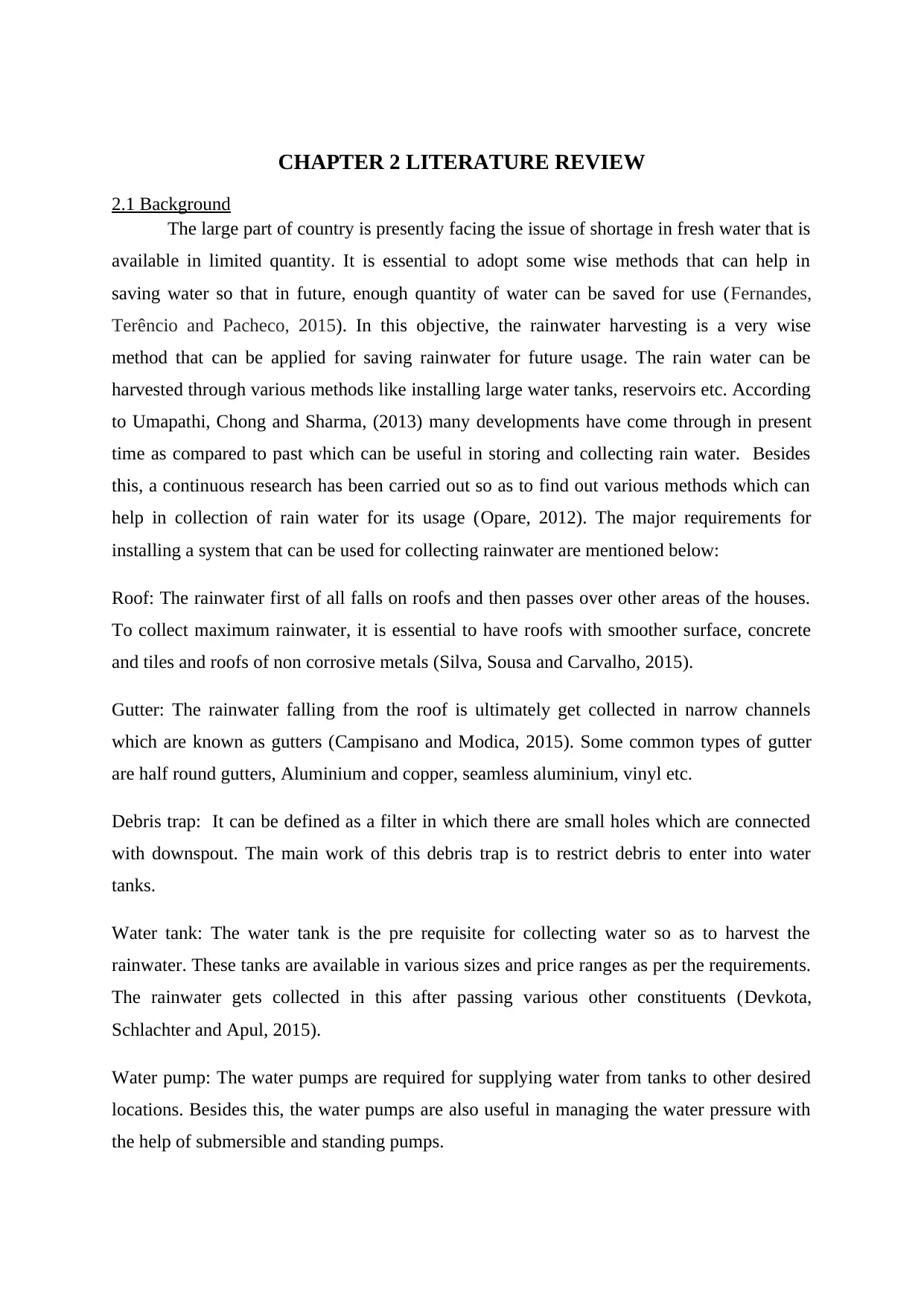
CHAPTER 2 LITERATURE REVIEW
2.1 Background
The large part of country is presently facing the issue of shortage in fresh water that is
available in limited quantity. It is essential to adopt some wise methods that can help in
saving water so that in future, enough quantity of water can be saved for use (Fernandes,
Terêncio and Pacheco, 2015). In this objective, the rainwater harvesting is a very wise
method that can be applied for saving rainwater for future usage. The rain water can be
harvested through various methods like installing large water tanks, reservoirs etc. According
to Umapathi, Chong and Sharma, (2013) many developments have come through in present
time as compared to past which can be useful in storing and collecting rain water. Besides
this, a continuous research has been carried out so as to find out various methods which can
help in collection of rain water for its usage (Opare, 2012). The major requirements for
installing a system that can be used for collecting rainwater are mentioned below:
Roof: The rainwater first of all falls on roofs and then passes over other areas of the houses.
To collect maximum rainwater, it is essential to have roofs with smoother surface, concrete
and tiles and roofs of non corrosive metals (Silva, Sousa and Carvalho, 2015).
Gutter: The rainwater falling from the roof is ultimately get collected in narrow channels
which are known as gutters (Campisano and Modica, 2015). Some common types of gutter
are half round gutters, Aluminium and copper, seamless aluminium, vinyl etc.
Debris trap: It can be defined as a filter in which there are small holes which are connected
with downspout. The main work of this debris trap is to restrict debris to enter into water
tanks.
Water tank: The water tank is the pre requisite for collecting water so as to harvest the
rainwater. These tanks are available in various sizes and price ranges as per the requirements.
The rainwater gets collected in this after passing various other constituents (Devkota,
Schlachter and Apul, 2015).
Water pump: The water pumps are required for supplying water from tanks to other desired
locations. Besides this, the water pumps are also useful in managing the water pressure with
the help of submersible and standing pumps.
2.1 Background
The large part of country is presently facing the issue of shortage in fresh water that is
available in limited quantity. It is essential to adopt some wise methods that can help in
saving water so that in future, enough quantity of water can be saved for use (Fernandes,
Terêncio and Pacheco, 2015). In this objective, the rainwater harvesting is a very wise
method that can be applied for saving rainwater for future usage. The rain water can be
harvested through various methods like installing large water tanks, reservoirs etc. According
to Umapathi, Chong and Sharma, (2013) many developments have come through in present
time as compared to past which can be useful in storing and collecting rain water. Besides
this, a continuous research has been carried out so as to find out various methods which can
help in collection of rain water for its usage (Opare, 2012). The major requirements for
installing a system that can be used for collecting rainwater are mentioned below:
Roof: The rainwater first of all falls on roofs and then passes over other areas of the houses.
To collect maximum rainwater, it is essential to have roofs with smoother surface, concrete
and tiles and roofs of non corrosive metals (Silva, Sousa and Carvalho, 2015).
Gutter: The rainwater falling from the roof is ultimately get collected in narrow channels
which are known as gutters (Campisano and Modica, 2015). Some common types of gutter
are half round gutters, Aluminium and copper, seamless aluminium, vinyl etc.
Debris trap: It can be defined as a filter in which there are small holes which are connected
with downspout. The main work of this debris trap is to restrict debris to enter into water
tanks.
Water tank: The water tank is the pre requisite for collecting water so as to harvest the
rainwater. These tanks are available in various sizes and price ranges as per the requirements.
The rainwater gets collected in this after passing various other constituents (Devkota,
Schlachter and Apul, 2015).
Water pump: The water pumps are required for supplying water from tanks to other desired
locations. Besides this, the water pumps are also useful in managing the water pressure with
the help of submersible and standing pumps.
⊘ This is a preview!⊘
Do you want full access?
Subscribe today to unlock all pages.

Trusted by 1+ million students worldwide
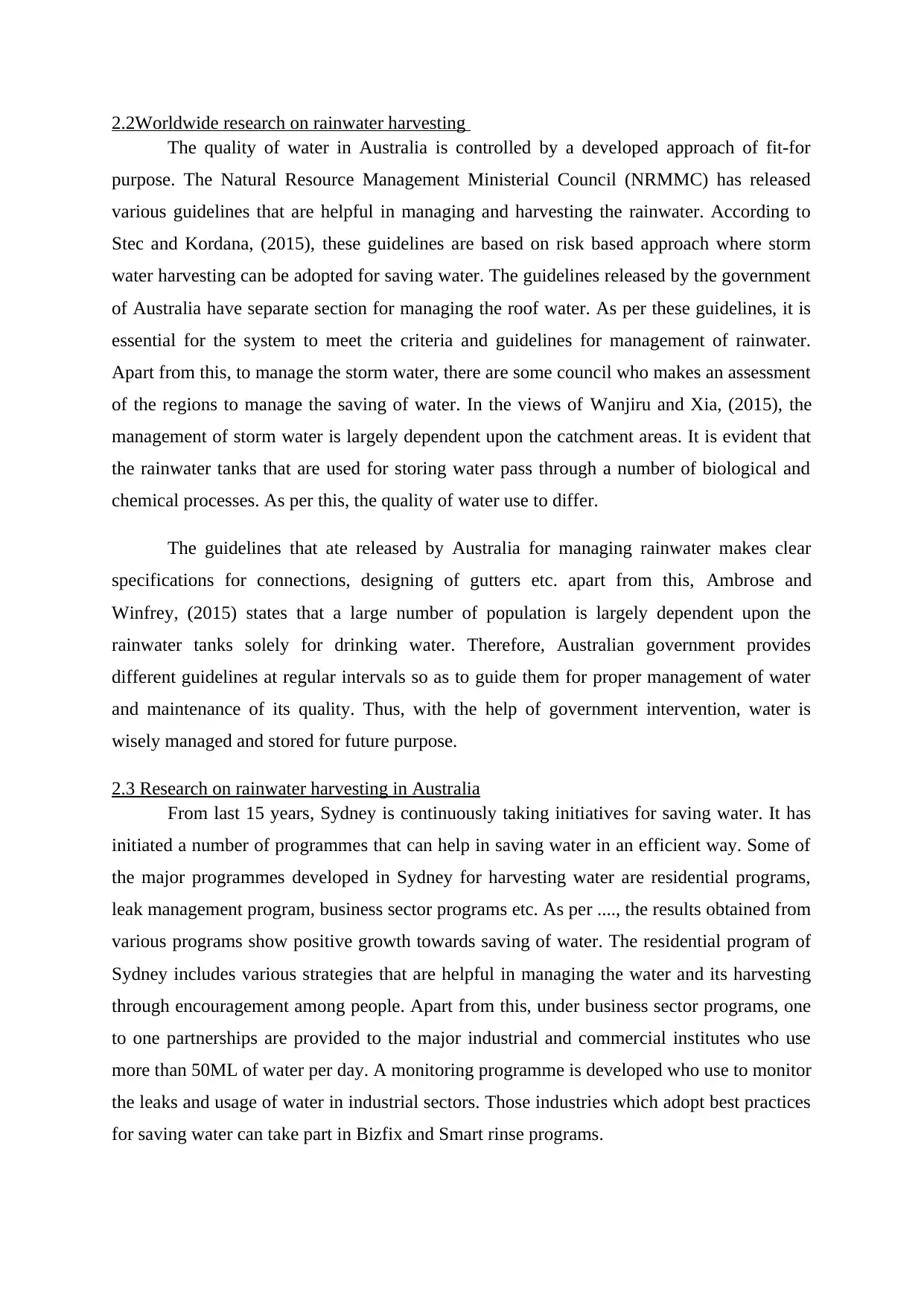
2.2Worldwide research on rainwater harvesting
The quality of water in Australia is controlled by a developed approach of fit-for
purpose. The Natural Resource Management Ministerial Council (NRMMC) has released
various guidelines that are helpful in managing and harvesting the rainwater. According to
Stec and Kordana, (2015), these guidelines are based on risk based approach where storm
water harvesting can be adopted for saving water. The guidelines released by the government
of Australia have separate section for managing the roof water. As per these guidelines, it is
essential for the system to meet the criteria and guidelines for management of rainwater.
Apart from this, to manage the storm water, there are some council who makes an assessment
of the regions to manage the saving of water. In the views of Wanjiru and Xia, (2015), the
management of storm water is largely dependent upon the catchment areas. It is evident that
the rainwater tanks that are used for storing water pass through a number of biological and
chemical processes. As per this, the quality of water use to differ.
The guidelines that ate released by Australia for managing rainwater makes clear
specifications for connections, designing of gutters etc. apart from this, Ambrose and
Winfrey, (2015) states that a large number of population is largely dependent upon the
rainwater tanks solely for drinking water. Therefore, Australian government provides
different guidelines at regular intervals so as to guide them for proper management of water
and maintenance of its quality. Thus, with the help of government intervention, water is
wisely managed and stored for future purpose.
2.3 Research on rainwater harvesting in Australia
From last 15 years, Sydney is continuously taking initiatives for saving water. It has
initiated a number of programmes that can help in saving water in an efficient way. Some of
the major programmes developed in Sydney for harvesting water are residential programs,
leak management program, business sector programs etc. As per ...., the results obtained from
various programs show positive growth towards saving of water. The residential program of
Sydney includes various strategies that are helpful in managing the water and its harvesting
through encouragement among people. Apart from this, under business sector programs, one
to one partnerships are provided to the major industrial and commercial institutes who use
more than 50ML of water per day. A monitoring programme is developed who use to monitor
the leaks and usage of water in industrial sectors. Those industries which adopt best practices
for saving water can take part in Bizfix and Smart rinse programs.
The quality of water in Australia is controlled by a developed approach of fit-for
purpose. The Natural Resource Management Ministerial Council (NRMMC) has released
various guidelines that are helpful in managing and harvesting the rainwater. According to
Stec and Kordana, (2015), these guidelines are based on risk based approach where storm
water harvesting can be adopted for saving water. The guidelines released by the government
of Australia have separate section for managing the roof water. As per these guidelines, it is
essential for the system to meet the criteria and guidelines for management of rainwater.
Apart from this, to manage the storm water, there are some council who makes an assessment
of the regions to manage the saving of water. In the views of Wanjiru and Xia, (2015), the
management of storm water is largely dependent upon the catchment areas. It is evident that
the rainwater tanks that are used for storing water pass through a number of biological and
chemical processes. As per this, the quality of water use to differ.
The guidelines that ate released by Australia for managing rainwater makes clear
specifications for connections, designing of gutters etc. apart from this, Ambrose and
Winfrey, (2015) states that a large number of population is largely dependent upon the
rainwater tanks solely for drinking water. Therefore, Australian government provides
different guidelines at regular intervals so as to guide them for proper management of water
and maintenance of its quality. Thus, with the help of government intervention, water is
wisely managed and stored for future purpose.
2.3 Research on rainwater harvesting in Australia
From last 15 years, Sydney is continuously taking initiatives for saving water. It has
initiated a number of programmes that can help in saving water in an efficient way. Some of
the major programmes developed in Sydney for harvesting water are residential programs,
leak management program, business sector programs etc. As per ...., the results obtained from
various programs show positive growth towards saving of water. The residential program of
Sydney includes various strategies that are helpful in managing the water and its harvesting
through encouragement among people. Apart from this, under business sector programs, one
to one partnerships are provided to the major industrial and commercial institutes who use
more than 50ML of water per day. A monitoring programme is developed who use to monitor
the leaks and usage of water in industrial sectors. Those industries which adopt best practices
for saving water can take part in Bizfix and Smart rinse programs.
Paraphrase This Document
Need a fresh take? Get an instant paraphrase of this document with our AI Paraphraser
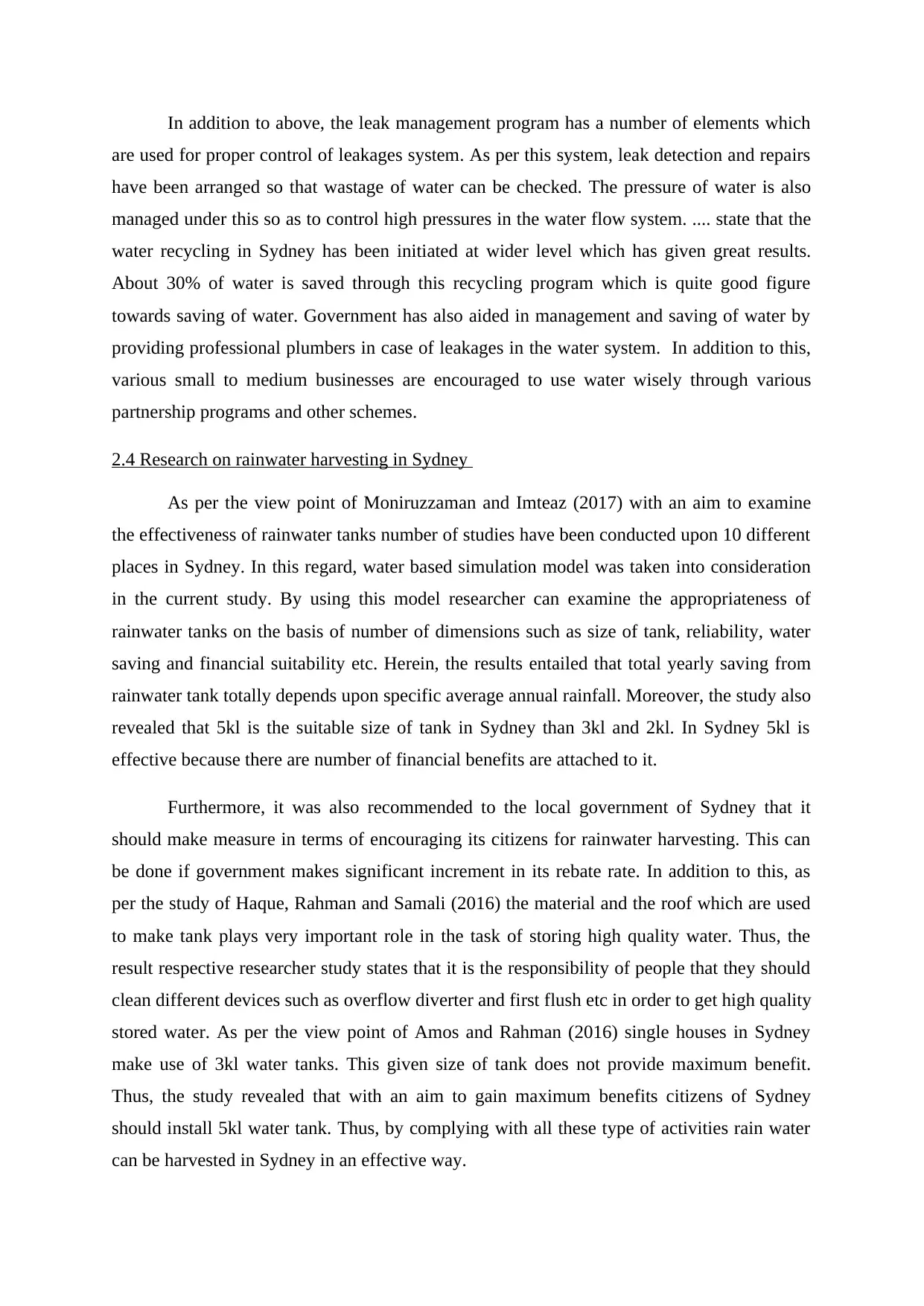
In addition to above, the leak management program has a number of elements which
are used for proper control of leakages system. As per this system, leak detection and repairs
have been arranged so that wastage of water can be checked. The pressure of water is also
managed under this so as to control high pressures in the water flow system. .... state that the
water recycling in Sydney has been initiated at wider level which has given great results.
About 30% of water is saved through this recycling program which is quite good figure
towards saving of water. Government has also aided in management and saving of water by
providing professional plumbers in case of leakages in the water system. In addition to this,
various small to medium businesses are encouraged to use water wisely through various
partnership programs and other schemes.
2.4 Research on rainwater harvesting in Sydney
As per the view point of Moniruzzaman and Imteaz (2017) with an aim to examine
the effectiveness of rainwater tanks number of studies have been conducted upon 10 different
places in Sydney. In this regard, water based simulation model was taken into consideration
in the current study. By using this model researcher can examine the appropriateness of
rainwater tanks on the basis of number of dimensions such as size of tank, reliability, water
saving and financial suitability etc. Herein, the results entailed that total yearly saving from
rainwater tank totally depends upon specific average annual rainfall. Moreover, the study also
revealed that 5kl is the suitable size of tank in Sydney than 3kl and 2kl. In Sydney 5kl is
effective because there are number of financial benefits are attached to it.
Furthermore, it was also recommended to the local government of Sydney that it
should make measure in terms of encouraging its citizens for rainwater harvesting. This can
be done if government makes significant increment in its rebate rate. In addition to this, as
per the study of Haque, Rahman and Samali (2016) the material and the roof which are used
to make tank plays very important role in the task of storing high quality water. Thus, the
result respective researcher study states that it is the responsibility of people that they should
clean different devices such as overflow diverter and first flush etc in order to get high quality
stored water. As per the view point of Amos and Rahman (2016) single houses in Sydney
make use of 3kl water tanks. This given size of tank does not provide maximum benefit.
Thus, the study revealed that with an aim to gain maximum benefits citizens of Sydney
should install 5kl water tank. Thus, by complying with all these type of activities rain water
can be harvested in Sydney in an effective way.
are used for proper control of leakages system. As per this system, leak detection and repairs
have been arranged so that wastage of water can be checked. The pressure of water is also
managed under this so as to control high pressures in the water flow system. .... state that the
water recycling in Sydney has been initiated at wider level which has given great results.
About 30% of water is saved through this recycling program which is quite good figure
towards saving of water. Government has also aided in management and saving of water by
providing professional plumbers in case of leakages in the water system. In addition to this,
various small to medium businesses are encouraged to use water wisely through various
partnership programs and other schemes.
2.4 Research on rainwater harvesting in Sydney
As per the view point of Moniruzzaman and Imteaz (2017) with an aim to examine
the effectiveness of rainwater tanks number of studies have been conducted upon 10 different
places in Sydney. In this regard, water based simulation model was taken into consideration
in the current study. By using this model researcher can examine the appropriateness of
rainwater tanks on the basis of number of dimensions such as size of tank, reliability, water
saving and financial suitability etc. Herein, the results entailed that total yearly saving from
rainwater tank totally depends upon specific average annual rainfall. Moreover, the study also
revealed that 5kl is the suitable size of tank in Sydney than 3kl and 2kl. In Sydney 5kl is
effective because there are number of financial benefits are attached to it.
Furthermore, it was also recommended to the local government of Sydney that it
should make measure in terms of encouraging its citizens for rainwater harvesting. This can
be done if government makes significant increment in its rebate rate. In addition to this, as
per the study of Haque, Rahman and Samali (2016) the material and the roof which are used
to make tank plays very important role in the task of storing high quality water. Thus, the
result respective researcher study states that it is the responsibility of people that they should
clean different devices such as overflow diverter and first flush etc in order to get high quality
stored water. As per the view point of Amos and Rahman (2016) single houses in Sydney
make use of 3kl water tanks. This given size of tank does not provide maximum benefit.
Thus, the study revealed that with an aim to gain maximum benefits citizens of Sydney
should install 5kl water tank. Thus, by complying with all these type of activities rain water
can be harvested in Sydney in an effective way.
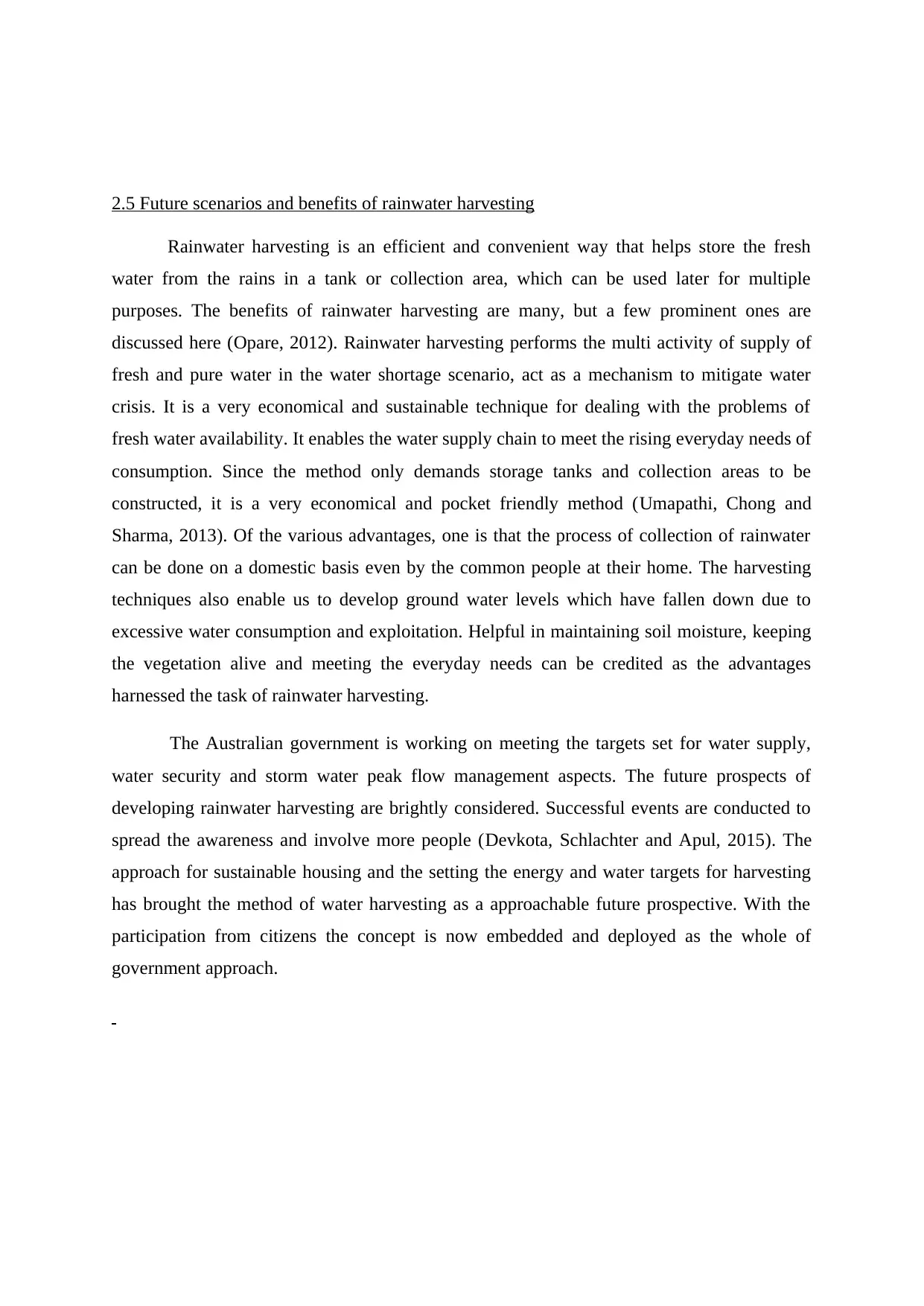
2.5 Future scenarios and benefits of rainwater harvesting
Rainwater harvesting is an efficient and convenient way that helps store the fresh
water from the rains in a tank or collection area, which can be used later for multiple
purposes. The benefits of rainwater harvesting are many, but a few prominent ones are
discussed here (Opare, 2012). Rainwater harvesting performs the multi activity of supply of
fresh and pure water in the water shortage scenario, act as a mechanism to mitigate water
crisis. It is a very economical and sustainable technique for dealing with the problems of
fresh water availability. It enables the water supply chain to meet the rising everyday needs of
consumption. Since the method only demands storage tanks and collection areas to be
constructed, it is a very economical and pocket friendly method (Umapathi, Chong and
Sharma, 2013). Of the various advantages, one is that the process of collection of rainwater
can be done on a domestic basis even by the common people at their home. The harvesting
techniques also enable us to develop ground water levels which have fallen down due to
excessive water consumption and exploitation. Helpful in maintaining soil moisture, keeping
the vegetation alive and meeting the everyday needs can be credited as the advantages
harnessed the task of rainwater harvesting.
The Australian government is working on meeting the targets set for water supply,
water security and storm water peak flow management aspects. The future prospects of
developing rainwater harvesting are brightly considered. Successful events are conducted to
spread the awareness and involve more people (Devkota, Schlachter and Apul, 2015). The
approach for sustainable housing and the setting the energy and water targets for harvesting
has brought the method of water harvesting as a approachable future prospective. With the
participation from citizens the concept is now embedded and deployed as the whole of
government approach.
Rainwater harvesting is an efficient and convenient way that helps store the fresh
water from the rains in a tank or collection area, which can be used later for multiple
purposes. The benefits of rainwater harvesting are many, but a few prominent ones are
discussed here (Opare, 2012). Rainwater harvesting performs the multi activity of supply of
fresh and pure water in the water shortage scenario, act as a mechanism to mitigate water
crisis. It is a very economical and sustainable technique for dealing with the problems of
fresh water availability. It enables the water supply chain to meet the rising everyday needs of
consumption. Since the method only demands storage tanks and collection areas to be
constructed, it is a very economical and pocket friendly method (Umapathi, Chong and
Sharma, 2013). Of the various advantages, one is that the process of collection of rainwater
can be done on a domestic basis even by the common people at their home. The harvesting
techniques also enable us to develop ground water levels which have fallen down due to
excessive water consumption and exploitation. Helpful in maintaining soil moisture, keeping
the vegetation alive and meeting the everyday needs can be credited as the advantages
harnessed the task of rainwater harvesting.
The Australian government is working on meeting the targets set for water supply,
water security and storm water peak flow management aspects. The future prospects of
developing rainwater harvesting are brightly considered. Successful events are conducted to
spread the awareness and involve more people (Devkota, Schlachter and Apul, 2015). The
approach for sustainable housing and the setting the energy and water targets for harvesting
has brought the method of water harvesting as a approachable future prospective. With the
participation from citizens the concept is now embedded and deployed as the whole of
government approach.
⊘ This is a preview!⊘
Do you want full access?
Subscribe today to unlock all pages.

Trusted by 1+ million students worldwide
1 out of 15
Related Documents
Your All-in-One AI-Powered Toolkit for Academic Success.
+13062052269
info@desklib.com
Available 24*7 on WhatsApp / Email
![[object Object]](/_next/static/media/star-bottom.7253800d.svg)
Unlock your academic potential
Copyright © 2020–2025 A2Z Services. All Rights Reserved. Developed and managed by ZUCOL.




